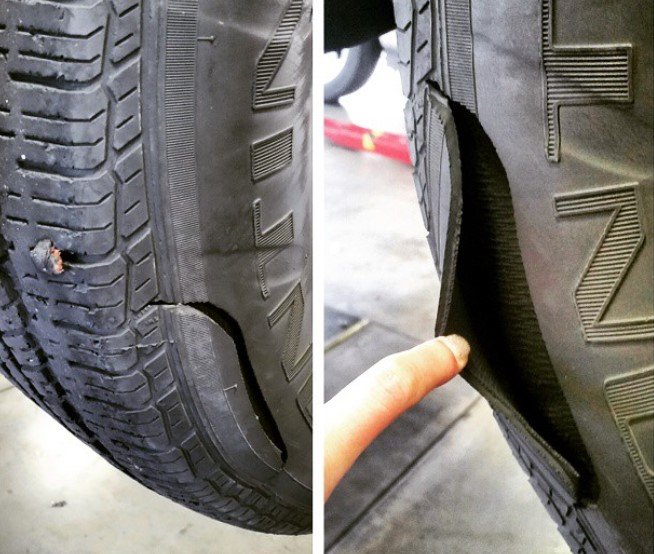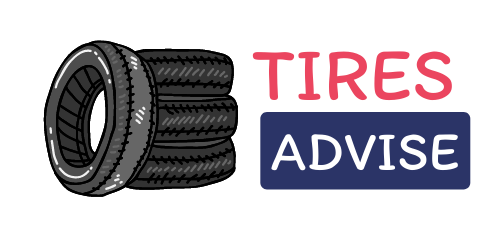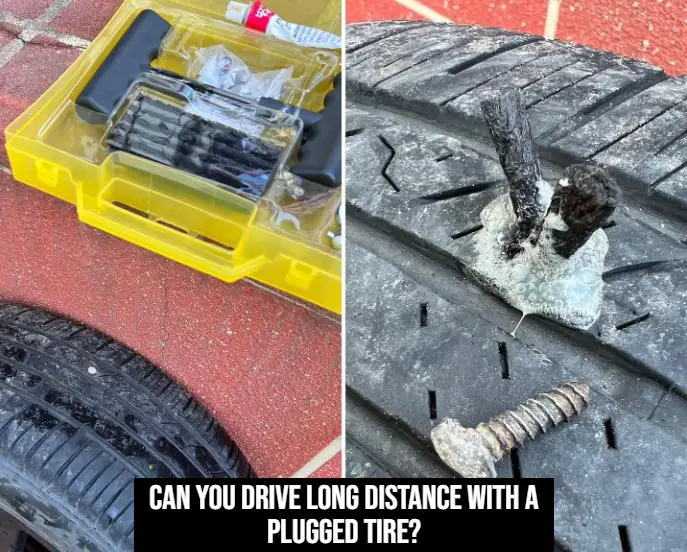Embarking on a long journey with your car, you might pause, questioning the reliability of a tire that’s been plugged after a puncture. It’s a common scenario: a nail in the road, a swift tire repair, and then the lingering doubt about the safety of a long drive ahead. The good news?
Yes, driving long distances with a plugged tire is generally safe if the tire has been repaired correctly. There is a catch to this assurance, though. It works well but requires prudence and an awareness of its limitations, much like a patched-up umbrella in a storm.
What is a Plugged Tire?
Definition and Basic Understanding
- A tire plug is like a quick band-aid for your tire. The purpose of this is to temporarily fill a small hole caused by things like nails or sharp rocks.
- It can be compared to a sticky, rubbery strip that covers the portion of the tire that comes into contact with the road.
- It’s a fast solution when you can’t get to a garage right away, but remember, it’s not a long-term fix.

The Plugging Process
- Fixing a tire with a plug is a bit like patching a leak in a water hose. You use a special kit with a rough tool to clean the hole and a sticky rubber string to seal it.
- The plug goes into the hole from the outside and is trimmed to be flush with the tire’s surface.
- It’s best for small holes, no bigger than the size of a pencil eraser, and only in the tread area, not the tire’s edge.
- While it gets you back on the road, it’s a temporary fix for a pair of jeans – useful for now, but you’ll need a proper fix soon.
Longevity and Performance of Plugged Tires
How Long Can You Rely on a Plugged Tire?
- A well-done tire plug can be like a trusty backpack, lasting for years. It can go for 7-10 years or up to 25,000 miles.
- The plug’s life depends a lot on how well it’s put in and the roads you drive on. If done right and driven on smooth roads, it can last as long as the tire itself.
- Remember, tire plugs are like a temporary patch on a leaky water pipe. It’s not meant to be a forever fix.
Performance at High Speeds
- Plugged tires can handle long trips, but be careful with big plugs near the tire’s edge.
- Driving fast, like when you’re rushing on a highway, can make the tire wear out unevenly. This could lead to more tire troubles.
- It’s usually okay to drive long distances with a properly plugged tire, but keep an eye on it. This is extra important if the plug lies close to the edge of the tire or if the roads are rough.
- As a rule of thumb, don’t drive faster than the tire’s speed limit, usually around 85 mph. It’s like not running too fast in new shoes; you want to be safe and not push it too hard.
Safety Considerations for Plugged Tires
The Role of Puncture Location and Size
- The spot and size of a tire puncture are like the location and size of a scratch on a phone screen. If it’s in the right spot and not too big, it can be managed.
- Plugs work best for small holes, less than 1/8″ wide, in the tire’s tread area, which is like the sole of a shoe.
- Avoid plugging if the puncture is near the tire’s edge (sidewall) or if you use your vehicle for tough jobs. It’s like putting a small bandage on a large cut; it won’t hold up.
Risks and Limitations
- Plugged tires, like a patched-up boat, are not meant for a long voyage. They’re just a quick fix.
- A plug might let air and water sneak into the tire, leading to rust and weakening the tire over time.
- Driving fast on a plugged tire can make it wear out unevenly, like running in lopsided shoes.
- Experts, including those who make tires and legal advisors, warn that plugs can be risky. They might be okay for a short time, but for long trips or heavy loads, they’re not the best choice. It’s like using a temporary spare tire; it works for a bit but isn’t meant for a long journey.
FAQs
How fast can you drive on a patched tire?
Driving on a patched tire is generally safe at normal speed limits. However, it’s best to avoid pushing the tire to its speed rating’s upper limits. For tires with plugs or sealants, staying below 50 mph is prudent, and it’s wise to not exceed 90 mph even with a well-patched tire.
Is it safe to plug a tire multiple times?
Plugging a tire more than once isn’t typically recommended. The suitability of a second plug depends on the puncture’s size and location. If the first repair was of high quality and the puncture was small and away from the sidewall, a second plug might be feasible. However, repeated plugging can compromise the tire’s integrity.
Are there any terrains to avoid with a plugged tire?
While a properly plugged tire can handle most terrains, it’s best to avoid rough, rocky, or gravel roads. These terrains can stress the plug and the tire, potentially leading to further damage. Regular monitoring of the tire’s condition is essential, especially in harsh driving conditions.
How does a plugged tire perform at high speeds?
A plugged tire may not perform as reliably as an unpatched tire at high speeds. The tire’s ability to handle stress and strain diminishes once repaired. Manufacturers often don’t support the original speed rating after a repair, so it’s advisable to drive cautiously and within moderate speed limits.

